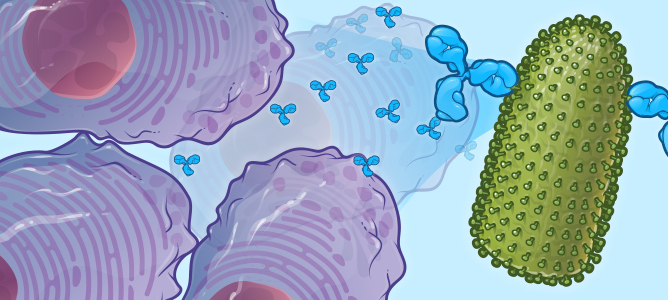Our Work
Case Study: Antibody Science

Challenge / Objective
When Zoetis, Inc., a veterinary pharmaceutical company, wanted to ramp up its education and communication program about monoclonal antibodies and immunotherapy to the veterinary dermatology community, Link Studio stepped up to produce a series of medical illustrations, interactive animations, and a video to dovetail with work previously created and to extend the reach of Zoetis’ communication about canine allergic disease. Initial market research (Step 1 of our Visual Pathway) suggested that there was a fundamental misunderstanding within the veterinary community about monoclonal antibodies and their use in immunotherapy. So our task was to develop a series of educational illustrations that would create a foundation of knowledge about the immune system and the role of antibodies within the immune system. So we had to address the basic science of antibody science and to dispel myths about the use of monoclonal antibodies for therapeutic purposes. Layered upon this, the intended visuals would need to communicate this information clearly, quickly, without extraneous information, and be able to integrate with a multi-faceted marketing approach.
Solutions / Results
In collaboration with Zoetis, Link Studio developed a list of key questions that should be addressed with these medical illustrations and interactive animations (Step 2 & 3 of our Visual Pathway). These questions became What are antibodies?; Why are antibodies so specific?; What is an epitope?; How do antibodies work to fight disease?; What happens to therapeutic antibodies in the body (what are the effects on the liver and kidneys)?; and, reaching back, What is the historical perspective of harnessing the immune system to fight disease? With these questions developed, we moved forward to develop preliminary visuals that would bring a consistent message to these questions. Through an iterative design process, we were able to develop a series of illustrations that used consistent visual language, and could be adapted to various platforms, such as print publication, Powerpoint presentations, interactive animations, and still illustrations for online consumption. During the development, the interaction between the narrative language and illustrative elements becomes of the utmost importance. Can an illustration stand on its own with little supporting text, or should there be an expansion of the textual content, so giving more depth to the visuals? Because of the inherent complexity of the immune system, it was decided that a simplified approach would be used to explain this information. Content could be implied with the illustrative elements, while the text would be used to drive the narrative pathway through the images. Thus, by striking the best balance between the implied and explicit content, the medical illustrations can be economized while allowing the audience to quickly gain the intended knowledge.





Client
- Zoetis
Category
- Medical Illustration
- Medical Animation
Industry
- Pharma / Biotechnology
- Marketing
- Veterinary Medicine
Audience
- Professional Education
Specialty
- Cell / Molecular Biology
- Veterinary Medicine